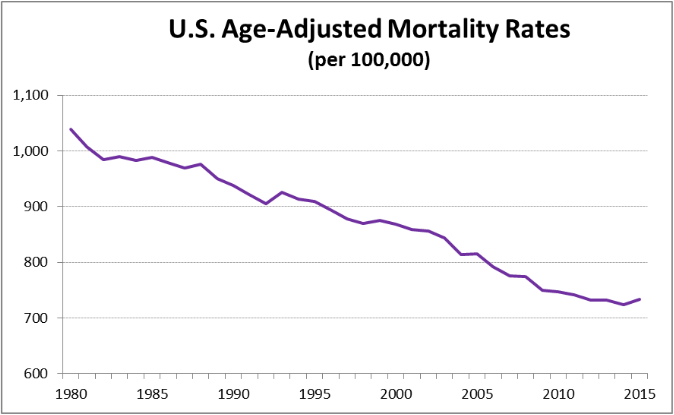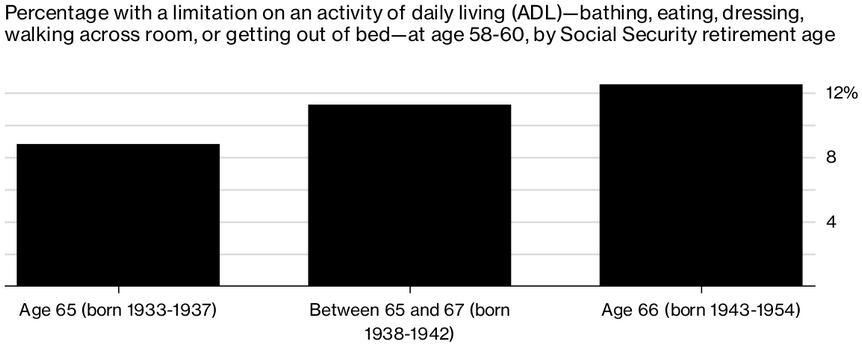At the same time that Americans’ life expectancy is stalling, the age at which people can claim their full Social Security benefits is gradually moving up, from 65 for those retiring in 2002 to 67 in 2027. Almost one in three Americans age 65 to 69 is still working, along with almost one in five in their early 70s. Meanwhile, Americans in their late 50s already have more serious health problems than people at the same ages did 10 to 15 years ago, (Choi & Schoeni, 2017). Researchers analyzed survey data to compare middle-age Americans’ health. A key measure is whether people have trouble with an “activity of daily living” (ADL), such as walking, dressing and bathing themselves, eating, or getting in or out of bed. The researchers observed that the number of middle-age Americans with ADL limitations has increased; 12.5% of Americans at the current retirement age of 66 had an ADL limitation in their late 50s, an increase from 8.8% for people with a retirement age of 65. At the current retirement age of 66, 25% of Americans age 58 to 60 rated themselves in “poor” or “fair” health. That’s up 2.6% from the group who could retire with full benefits at 65, the researchers found. Cognitive skills have also declined over time, according to the study. For those with a retirement age of 66, 11% already had some kind of dementia or other cognitive decline at age 58 to 60; an increase from 9.5% of Americans with a retirement age between 65 and 66. While death rates can fluctuate from year to year, this study is being added to a growing body of evidence that suggests the health of Americans deteriorating. References Choi, H. and Schoeni, R. (2017). Health Of Americans Who Must Work Longer To Reach Social Security Retirement Age. Health Affairs, 36(10), pp.1815-1819. https://doi.org/10.1377/hlthaff.2017.0217
Society of Actuaries. (2017). Mortality Improvement Scale 2017. [online] Available at: https://www.soa.org/Files/Research/Exp-Study/mortality-improvement-scale-mp-2017.pdf [Accessed 28 Oct. 2017]. Steverman, B. (2017). Americans Are Retiring Later, Dying Sooner and Sicker In-Between. [online] Bloomberg.com. Available at: https://www.bloomberg.com/news/articles/2017-10-23/americans-are-retiring-later-dying-sooner-and-sicker-in-between [Accessed 28 Oct. 2017].
0 Comments
Researchers set out to identify geographical characteristics that constitute an enriched environment affecting the human brain. A total of 341 older adults participated to establish three latent brain factors (amygdala, pACC and dorsolateral prefrontal cortex (DLPFC)) to test the effects of forest, urban green, water and wasteland around the home address. The results reveal a significant positive association between the coverage of forest and amygdala integrity. This evidence suggests that forests may have health-promoting effects on the integrity of the amygdala. Since cross-sectional data does not allow causal inference it could also be that individuals with high structural integrity choose to live closer to forest (Kühn et al., 2017). Background In experiments conducted on rodents, researchers have observed experience-dependent alterations of the brain in the form of adult neurogenesis and synaptic plasticity using so-called “enriched environments”. In such an environment, rats could roam freely with those held in cages with access to food, water and bedding. That is, a complex environment that offers a higher degree of stimulation has been observed to facilitate brain plasticity as revealed by studies measuring neurons. Still the evidence acquired in studies on enriched environments in animals provides important information to infer what an enriched environment may look like in humans. At first sight one may conclude that city dwellers experience more complexity and novelty in their environment compared to people living in more rural regions. However, in contrast to this, a growing body of research suggests that urban environments encompasses a set of adverse psychosocial influences that facilitate chronic stress. This is in line with epidemiological evidence showing that mental health problems are more frequent in urban as compared to rural areas. This has been shown for mood and anxiety disorders as well as schizophrenia, with up to 56% higher prevalence rates when comparing most to least urbanized regions. Reasons for this may lie in the repeated infringement of personal space in cities that may trigger the brains’ threat system and in particular the repeated exposure to strangers may facilitate chronic engagement of the amygdala. At the same time a growing body of research has shown that living close to natural landscapes has beneficial effects on mental health as well as well-being, mood, cognition, but also longevity and mortality. Researchers have observed that moving to greener urban areas is associated with improvements in mental health. Moreover, it has been shown that more green space in deprived urban neighbourhoods is associated with less perceived stress and healthier diurnal cortisol responses. In Japan a so-called practice of “forest bathing” has been established under the term “Shinrin-yoku”. Although the empirical evidence base on Shinrin-yoku is small, first studies have demonstrated beneficial effects of passive viewing and active exploration of forest landscapes onto stress markers such as concentrations of cortisol, pulse rate, blood pressure, parasympathetic and sympathetic nerve activity. Green landscapes and forests may be viewed as environmental enrichment factors in humans. What has been shown in the neuroscientific literature is that urban upbringing and city living might be detrimental by affecting stress processing in humans. More concretely, current city living has been associated with increases in amygdala activity in comparison to living in more rural areas, whereas being brought up in an urban environment in the first 15 years of life increased stress related functional brain activity in the perigenual anterior cingular cortex (pACC). Researchers set out to apply established characteristics of geographical features within cities in more depth and associate these cross-sectionally with brain structural integrity. The purpose of the study was to investigate what may constitute an enriched environment for human beings on the micro level within the city of Berlin, complementing previous studies that discriminated brain differences of inhabitants of cities, towns and rural regions on the macro level (Kühn et al., 2017). ReferencesAmemori, K. and Graybiel, A. (2012). Localized microstimulation of primate pregenual cingulate cortex induces negative decision-making. Nature Neuroscience, 15(5), pp.776-785. https://doi.org/10.1038/nn.3088
Ernst, J., Hock, A., Henning, A., Seifritz, E., Boeker, H. and Grimm, S. (2016). Increased pregenual anterior cingulate glucose and lactate concentrations in major depressive disorder. Molecular Psychiatry, 22(1), pp.113-119. https://doi.org/10.1038/mp.2016.73 Kühn, S., Düzel, S., Eibich, P., Krekel, C., Wüstemann, H., Kolbe, J., Martensson, J., Goebel, J., Gallinat, J., Wagner, G. and Lindenberger, U. (2017). In search of features that constitute an “enriched environment” in humans: Associations between geographical properties and brain structure. Scientific Reports, 7(1). https://doi.org/10.1038/s41598-017-12046-7 A growing body of evidence suggests that exercise is one of the most effective prevention and treatment strategies for depression. A recent study, conducted over the course of 11 years, was designed to address whether exercise provides protection against new-onset depression and anxiety and if so, the intensity and amount of exercise required to gain protection and, lastly, the mechanisms that underlie any association. Researchers evaluated and followed 33,908 adults, which were selected on the basis of having no symptoms of common mental disorder or limiting physical health conditions. The researchers observed that regular leisure-time exercise was associated with reduced incidence of future depression but not anxiety. The majority of this protective effect occurred at low levels of exercise and was observed regardless of intensity. After adjusting for confounding variables, the results suggests that 12% of future cases of depression could have been prevented if all participants had engaged in at least 1 hour of physical activity each week. The social and physical health benefits of exercise explained a small proportion of the protective effect. ReferencesHarvey, S., Øverland, S., Hatch, S., Wessely, S., Mykletun, A. and Hotopf, M. (2017). Exercise and the Prevention of Depression: Results of the HUNT Cohort Study. American Journal of Psychiatry, pp.appi.ajp.2017.1. https://doi.org/10.1176/appi.ajp.2017.16111223
|
The Awareness domain contains research, news, information, observations, and ideas at the level of self in an effort to intellectualize health concepts.
The Lifestyle domain builds off intellectual concepts and offers practical applications.
Taking care of yourself is at the core of the other domains because the others depend on your health and wellness.
Archives
May 2024
Categories
All
|





 RSS Feed
RSS Feed

